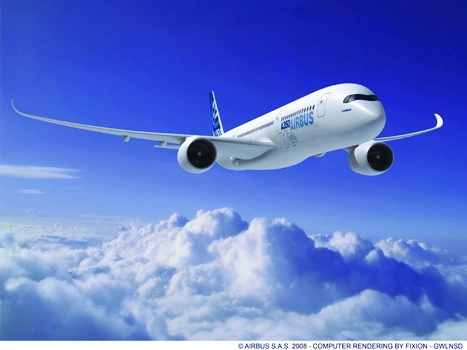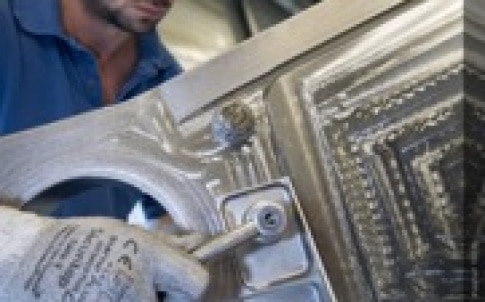The application of additive manufacturing for the production of aerospace components has a long and well-documented history. In fact, 3D printed components are already flying on Airbus planes. Titanium brackets built using additive-layer manufacturing are in use on Airbus’s series production commercial aircraft, the A350 XWB.
3D printed parts installed in aircraft also include cabin brackets and bleed pipes which have already flown on Airbus A320neo and A350 XWB test aeroplanes.

This installation is the product of advanced manufacturing and the result of a partnership representing the first 3D printed component to be implemented on an Airbus commercial aircraft. It comes after a series of installations of similar parts on test aircraft.
When applied to aircraft, the additive layer manufacturing technique has resulted in a 30 percent reduction of the weight, compared with conventional manufactured parts with the same function. An Airbus A320 nacelle hinge bracket has also been optimised through AM technology, incorporating a new topology method and metal powder manufacturing improvement process. As a result, the part has met all functional and strength requirements, whilst reducing costs and increasing production – a significant step for the economic viability of 3D printing of parts.
Process control and identification of parameters in AM
Advanced research using AM technology can improve surface quality, microstructure variability, powder control process and process parameters. To safely increase 3D printed parts for additional uses in the Airbus fleet, we - together with our partner – continue to develop new advanced technology processes.
Analysing the defects both inside and outside the powder bed process is key to this research to assess requirements within the limit of the defect´s threshold and a bionic design optimisation.

The objective of this test campaign is to validate a new manufacturing technique that can increase the rapid application of AM in the aircraft industry. AM could reduce the mass of individual assemblies by up to 50 percent and result in weight savings in aircraft construction.
Identifying and characterising key failure modes and defects can, ultimately, help to reduce production costs, waste, toxicity and energy use. In general, the shape of 3D printing parts can reduce the raw material waste produced during milling by 90 percent, dramatically reducing the energy demand for production.
Controlling the process chain and the anomalies produced during the AM process also helps to establish Process Control, enabling repeatable and predictable part quality.
Currently, the only way to produce aerospace quality parts using the AM powder bed process requires a long process chain with a lot of steps in the post processing. The intention of the test campaign of 3D titanium powder component is to shorten this chain and to analyse fatigue life cycles impacted by defects. These properties are influenced by a high number of factors including the technical build process parameters.
A first step in the research was to investigate the laser beam melting process chain for ways to avoid the Hot Isostatic Pressing (HIP) process, which can help to optimise the process and cost of AM part production. To ensure the safety is not in any way compromised, parts created without the HIP process need to be analysed to ensure that they are fully robust despite the technical changes in the build process. Successively the fatigue and crack propagation analysis are compared with its existing flight-worthy counterpart.
Probabilistic model used to investigate defect´s effects of fatigue on AM
The analysis, based on a probabilistic approach of crack propagation behaviour, is implemented in a tool containing comprehensive information and detailed analysis of critical defects that occur in the AM parts, such as porosity and surface roughness.
If the test results yield defects that fall below the threshold for failure (or a lack of defects altogether), the test parts will then undergo fatigue testing to ensure they are robust enough to meet the industry’s rigorous safety standards. For example, void and inclusion defects are only acceptable when they do not affect safety requirements and functionality at any time during their lifetimes.
The use of the probabilistic technique with the correlated defect and stress tests also help to identify the most critical defects. High severity detection of defects impacts the limitation of the AM. By characterising the defects and their consequences, we can work to safely extend the use of AM to a wider range of aircraft applications.
By combining expertise in metal additive manufacturing and metallurgy with Airbus’s know-how in final aircraft part design and qualification, we are paving the way for future applications of metals-based additive technologies for creating aircraft bionic components. Results of these tests will help no only to reduce costs and weight, but also the environmental impact of future aircraft.
Dr Paola Caracciolo - Airframe Research & Technology, Airbus Commercial Germany
If you’d like to learn more about defects testing for 3D printed parts in the aerospace industry, come hear Paola speak and share the results of her latest research at this year’s Additive International (formerly the International Conference on Additive Manufacturing & 3D Printing) in Nottingham from 10-12th July.
Register at: https://www.additiveinternational.com/





Poll: Should the UK’s railways be renationalised?
I think that a network inclusive of the vehicles on it would make sense. However it remains to be seen if there is any plan for it to be for the...